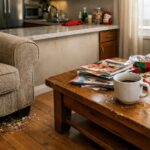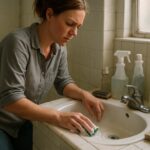Sticky messes and stubborn stains often show up on kitchen counters. Everyone wants a clean, shiny surface, but crumbs, spills, and grime seem to come back every day. It gets frustrating fast.
Did you know different countertop materials need special care? One approach does not fit all surfaces. What keeps granite nice might harm butcher block or leave streaks on stainless steel.
This article offers smart, frugal tips for every kind of counter. Readers will learn easy cleaning steps that save time and money. Simple tools help make Clean Countertops part of any Daily Cleaning Routine.
Get ready for cleaner counters by tonight!
Key Takeaways
- Always test cleaning products on a small, hidden area of your countertop first to prevent damage.
- Use materials appropriate for your countertop type – mild dish soap and water work for most surfaces, but natural stone requires special care.
- Clean spills immediately to avoid stains and germs, especially on porous surfaces like wood or stone.
- Avoid abrasive cleaners and scrubbers that can harm the finish of your countertops.
- Regular sealing is crucial for granite, marble, and butcher block counters to protect them from stains and damage.
Materials Needed for Cleaning Countertops
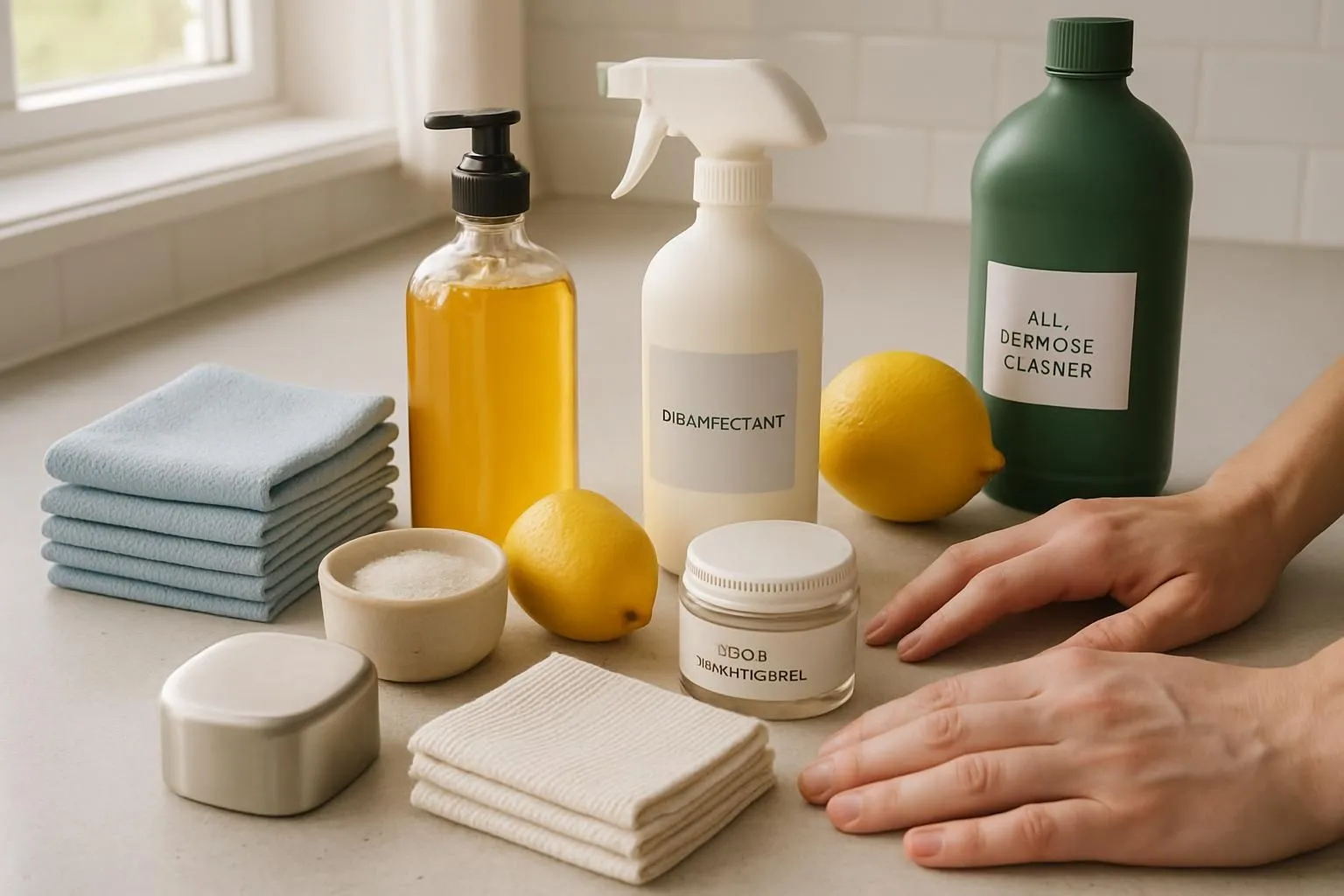
Shifting from the introduction, it’s crucial to know what you’ll need to make those countertops shine. The right tools and cleaners can make all the difference.
- Microfiber cloths are a must, needing at least two for a cleaning spree. They’re soft, effective, and won’t scratch your surfaces.
- Dish soap like Palmolive Ultra Pure + Clear is gentle yet powerful enough for daily cleaning tasks without harming sealants.
- Disinfectant sprays should be used with care; acidic ones can ruin natural stone countertops.
- For tough stains on wooden surfaces, kosher salt and half a lemon work wonders.
- Sealer is essential for granite or marble countertops to keep them looking new. Use it as necessary.
- A food-grade wood conditioner, such as Howard Butcher Block Conditioner, keeps butcher block counters in top condition.
- Williams Sonoma All Purpose Pantry Towels are great for spills and general cleanup.
- Biokleen Spray & Wipe All-Purpose Cleaner is an EPA Safer Choice that ensures your cleaning routine is safe for everyone in the house.
With these materials at hand, you’re well-equipped to tackle countertop cleaning without fretting over damage or inefficiency.
Pre-Cleaning Guidelines
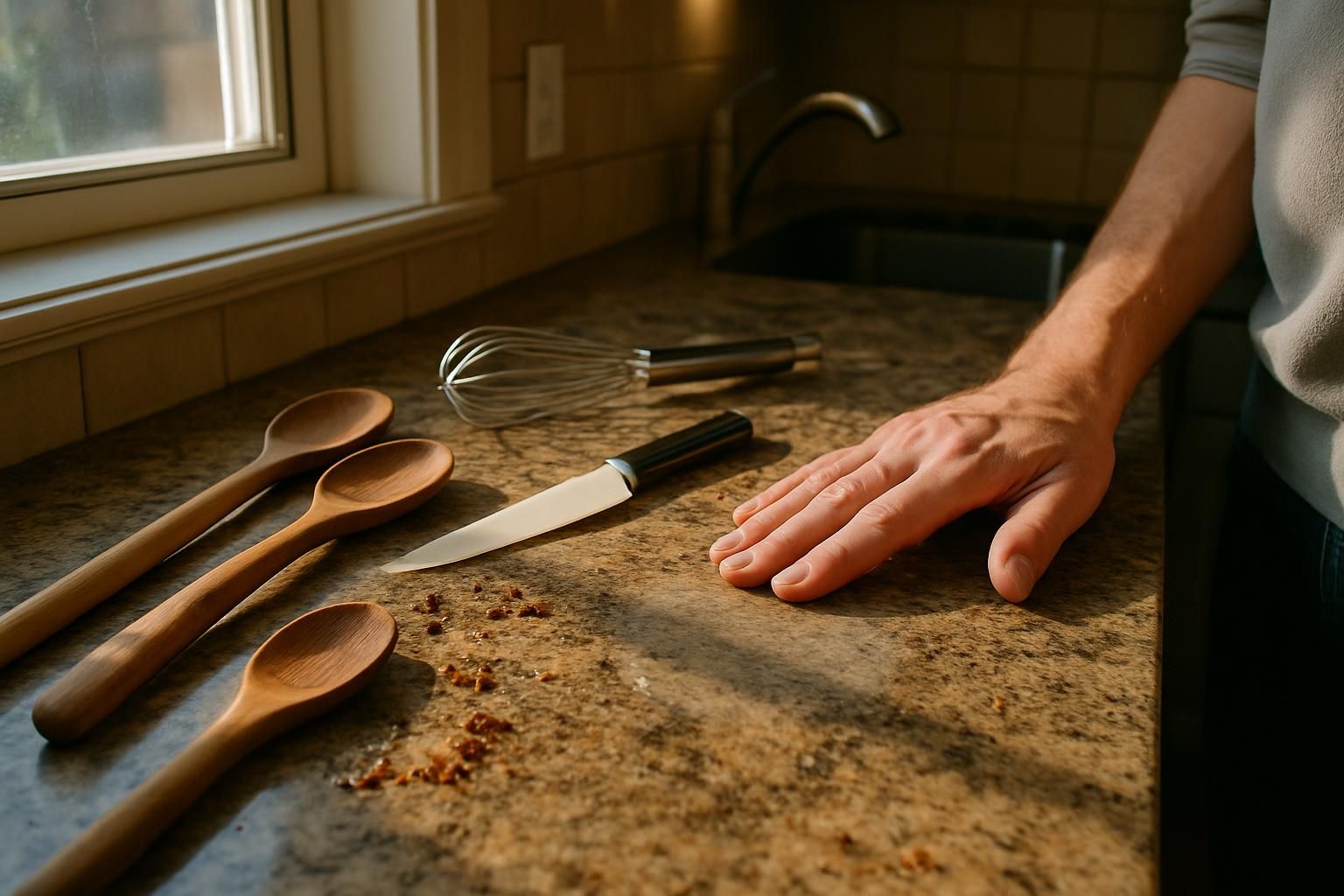
First, clear off anything that might get in the way. Next, try out your cleaner on a hidden spot so there are no surprises later.
Remove debris and loose items
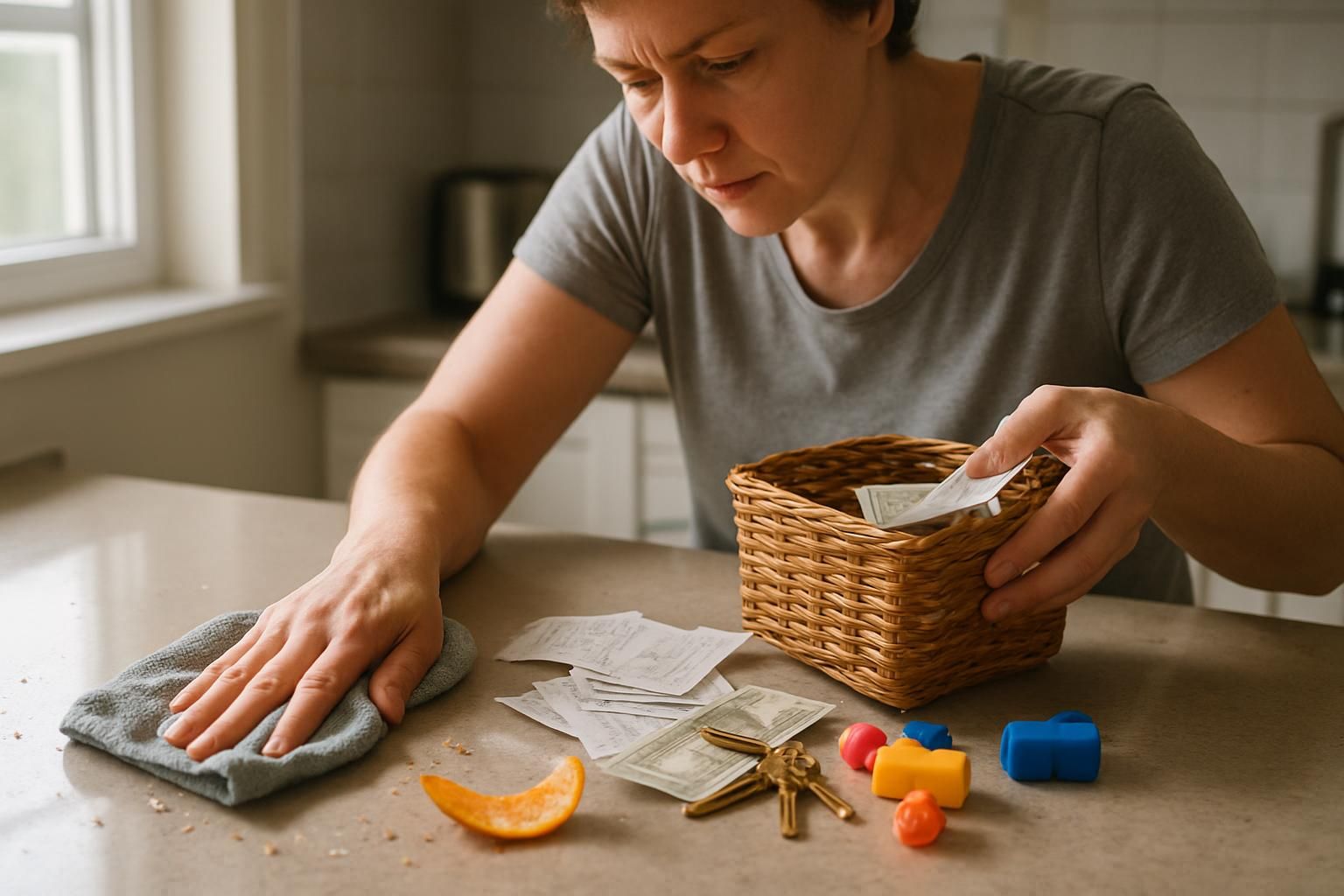
Sweep crumbs and scraps off the countertop using a microfiber cloth, counter brush, or even paper towels. Kick that morning’s toast crust into the compost bin instead of letting it linger.
Toys, keys, bills everything finds its way onto counters. Stash loose items in a basket or return them to their proper home before cleaning begins.
Peeling an orange left sticky bits on the surface? Wipe these up with a cotton cloth for good sanitation. Dust sneaks into kitchen corners fast; give surfaces a quick dusting so nothing muddles your tidy mission.
This step sets up an easier wipe-down later and keeps things organized for busy parents trying to wrangle daily chaos!
Test cleaners on a small, inconspicuous area
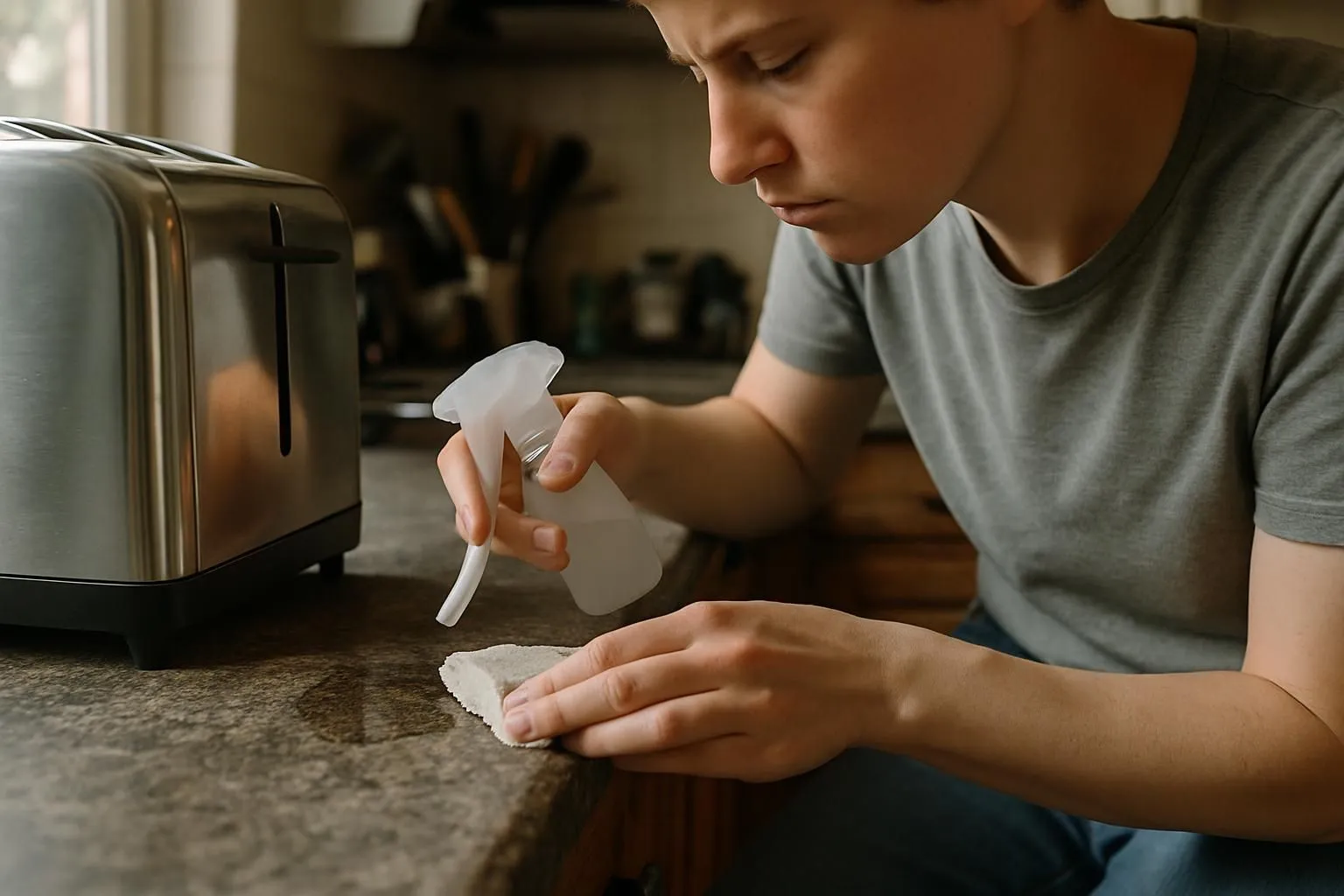
After clearing bread crumbs and stray toys, a surface test is the next step. Dab the cleaning solution on a hidden corner under your toaster or behind your coffee maker. Stone care experts always warn against skipping this spot-check.
Baking soda, hydrogen peroxide, and vinegar can mess with pH balance, so check compatibility first.
Many countertops contain porous material that absorbs residue quickly. Countertop damage often costs upwards of $500 to repair according to HomeAdvisor’s 2025 data. A simple patch test saves expensive headaches later by preventing stains or color fading before they start spreading across visible areas.
Avoid acidic disinfectants like straight lemon juice on granite; it eats away the sealant faster than you think!
General Cleaning Methods for Countertops

Wipe countertops every day with warm soapy water and a soft cloth. This simple habit keeps grime at bay and leaves surfaces looking fresh.
Use mild dish soap and warm water
Mix a few drops of gentle dish detergent in a bowl of warm water. Dip a soft cloth or nonabrasive sponge into the cleaning solution, then wipe the kitchen countertops in small circles.
This combo lifts grease and dirt without harming surfaces or sealants. Parents appreciate how simple and safe this method works for daily Surface Cleaning.
Mild dish soap cleans most messes yet does not strip away protective finishes. Warm water helps loosen sticky spots and makes Stain Removal easier. Using harsh cleaners too often can dull counters, but mild ingredients keep them sparkling with less risk.
Even kids can help out using this cleaning trick under supervision, turning cleanup into quality family time instead of just another chore on the list.
Use a microfiber cloth or sponge for wiping
Following up on using mild dish soap and warm water, choose a microfiber cloth or sponge for wiping the countertops. Microfiber grabs onto dirt better than paper towels or old rags.
Make long swipes across the surface instead of scrubbing in circles; this covers more ground and leaves fewer streaks behind.
Rinse the cloth regularly to clear away excess soap suds during cleaning. After finishing, dry the countertop with a fresh cotton or microfiber towel to stop any lingering moisture from causing spots.
Cleaning like this is simple enough for beginners and can be done in under 2 hours. Parents will love how quick it is even with kids running around asking what’s for dinner!
Cleaning Different Types of Countertop Surfaces

Every countertop tells its own story and needs a specific cleaning trick. Let’s look at what keeps each surface looking bright and ready for action.
Granite and Marble Countertops
Granite and marble countertops need gentle treatment to stay beautiful. Wipe these kitchen surfaces with a microfiber or cotton cloth dipped in warm water and a splash of dish soap.
Skip acidic cleaners because they can eat away at the surface and dull its shine. Spots from oil-based spills respond well to baking soda, while hydrogen peroxide helps lift water-based stains.
These countertop materials soak up liquids if their seal wears out, so check them every six months or if you see water sinking into the stone within 3-4 minutes.
Keep cleaning solutions simple for daily care; fancy sprays often do more harm than good here. Kids waiting for snacks might drum on the island, but no worries regular wiping keeps those fingerprints away! Resealing granite or marble protects your investment and leaves the surface gleaming much longer.
Treat these natural beauties right, and they’ll hold strong against pizza nights, science projects, and family feasts year after year.
Laminate Countertops
Laminate countertops handle busy kitchens but need gentle cleaning. Spray a mild, multi-purpose household cleaner on the surface and grab a reusable soft cloth for wiping. Sticky marks give way with some elbow grease from a nonabrasive sponge or microfiber cloth.
Drop the bleach and skip harsh scrubbing pads; these can scratch or dull that smooth surface fast.
For stubborn stains, mix baking soda with warm water to form a paste. Smear it over trouble spots and let it sit for 5 to 10 minutes before gentle scrubbing. This easy method often lifts everything from juice spills to crayon lines left by little artists at breakfast time.
Next up: see how wood surfaces like butcher block need different care for their unique charm.
Butcher Block Countertops
Unlike laminate, butcher block countertops need a different kind of care. Wood countertops soak up moisture and stains fast, so quick cleaning matters. Wipe the surface with mild dish soap and warm water after each use.
For deeper stains, sprinkle salt over the area and scrub it in using half a lemon. A tangy twist keeps germs away too! After this, wipe down with a cloth dampened with vinegar-water for clean wood.
Parents often worry about scratches from knives or toys banging on the counter. Dab on butcher block oil or mineral oil to hide small marks and keep wood looking fresh; do this every month during the first year, then every six months after that.
Never skip sealing because water spots can creep in without warning. Natural cleaners work best here skip bleach unless you want faded patches! This simple routine saves time later and keeps your countertop safe for family snacks or school projects alike.
Quartz Countertops
Unlike butcher block, quartz countertops need less fuss. These nonporous surfaces keep spills from soaking in, which helps with hygiene and Stain Removal. Busy parents can quickly wipe up sticky messes with mild dish soap and a soft cloth.
For stubborn stains that refuse to budge, glass cleaner often does the trick.
Disinfection feels like a breeze here. Mix isopropyl alcohol with water then dampen a clean sponge or rag for wiping down the surface. Afterward, rinse well so no cleaner lingers behind.
Skip any talk of resealing quartz keeps its durability without extra maintenance routines or sealant treatments year after year.
Soapstone Countertops
Soapstone countertops need gentle care to stay gorgeous. Tackle Daily Cleaning Routine messes with a soft microfiber or cotton cloth and mild dish soap. Warm water works wonders on Surface Cleaning stains, even after pancake syrup spills or tomato sauce accidents from last night’s dinner.
Skip the sealer for this natural stone; mineral oil does the heavy lifting. Rub in a thin coat of mineral oil every month to keep colors rich and streaks at bay.
Household cleaners with bleach can tackle germs, but always dilute them first. Rinse every soapy or bleached spot right away using clean water kids often help themselves in the kitchen, so play it safe! Avoid scouring pads because they scratch easily.
Spot stubborn marks? Don’t panic; light buffing with sandpaper usually helps without fuss. For more details about caring for tile countertop surfaces next, let’s keep going down our cleaning checklist.
Tile Countertops
Tile countertops need regular care for a fresh look. Use a cleaning solution of mild dish soap and water to wipe the tiles with a soft microfiber cloth or sponge. Scrub grout lines using a grout cleaner as directed, since food and grime hide there like mischief in kids’ pockets.
For Surface Cleaning stains, pick a nonabrasive stain removal product that is approved for tile so you avoid scratches.
Drop bleach sprays on the tiles; use only material-approved disinfectants. Spray, let sit briefly, then wipe clean to achieve good sanitation without risking damage to the finish or grout color.
Apply sealing every few years to keep moisture out of both tile and grout; this helps with long-term Countertop Maintenance by making future cleanup easier. Curious about keeping stainless steel countertops just as sparkly? Keep reading for more tips under the next section.
Stainless Steel Countertops
Stainless steel countertops shine brightest with simple care. A microfiber or cotton cloth and warm water mixed with a drop of dish soap handle most Daily Cleaning Routine messes without scratching the surface.
For sticky fingerprints, lemon oil works wonders; apply a dab and buff gently using a clean microfiber cloth to keep smudges at bay. Disinfect kitchen surfaces by spraying a nonbleach cleaner approved for stainless steel, then wipe dry in the grain’s direction for best results.
No sealer is needed since stainless steel resists staining on its own. Parents can relax knowing these countertops shrug off the chaos of family life spilled juice, cookie dough fingerprints, even pizza sauce splatters wash away easily.
Using too much force or scrubbers scratches that soft glow though, so nonabrasive cleaning wins every time. Regular quick wipes prevent buildup and help maintain that modern gleam day after day without extra fuss.
Removing Stains from Countertops
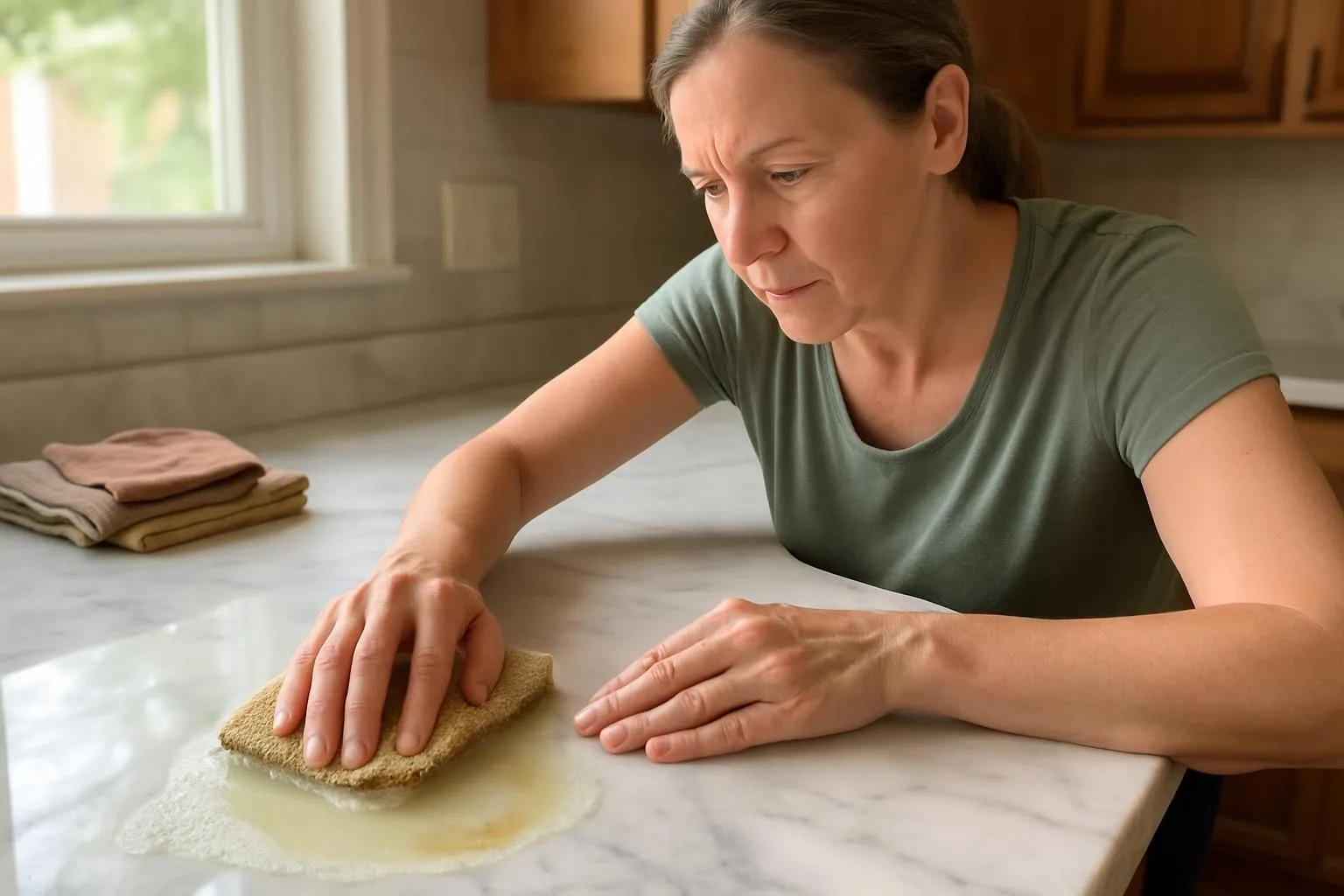
Sticky spots and old stains can feel like stubborn guests who just won’t leave. With the right tricks, a clean surface is only a few easy steps away.
Baking soda paste for stubborn stains
Mix baking soda with warm water to make a paste. Spread this cleaning solution right onto stubborn stains on marble, granite, laminate, or stainless steel countertops. Let it sit for 5 to 10 minutes.
This stain removal trick acts as a mild abrasive so it breaks up spots without harming surfaces.
For the toughest cases, cover the paste with plastic wrap and secure it using masking tape. Leave it overnight for deeper countertop care. Scrub gently in the morning and rinse thoroughly.
Baking soda works as a nontoxic household cleaner that keeps your kitchen sparkling clean while protecting your investment from harsh chemicals or permanent marks.
Vinegar and water solution for specific surfaces
After tackling stubborn stains with baking soda paste, some countertops crave different attention. Wood and butcher block surfaces demand gentle care. First, treat stains with lemon juice and salt scrub for a natural punch.
Afterward, swipe the area using a cloth dampened in a vinegar and water solution.
This cleaning solution helps lift leftover residue while keeping wood healthy. Vinegar acts as a natural cleaning solution but does not harm sealed finishes when used sparingly. For Kitchen Hygiene, use this mix lightly on wood to keep counters fresh without overdoing it.
This home remedy keeps up regular countertop care without needing harsh chemical products or endless scrubbing marathons.
Disinfecting Countertops
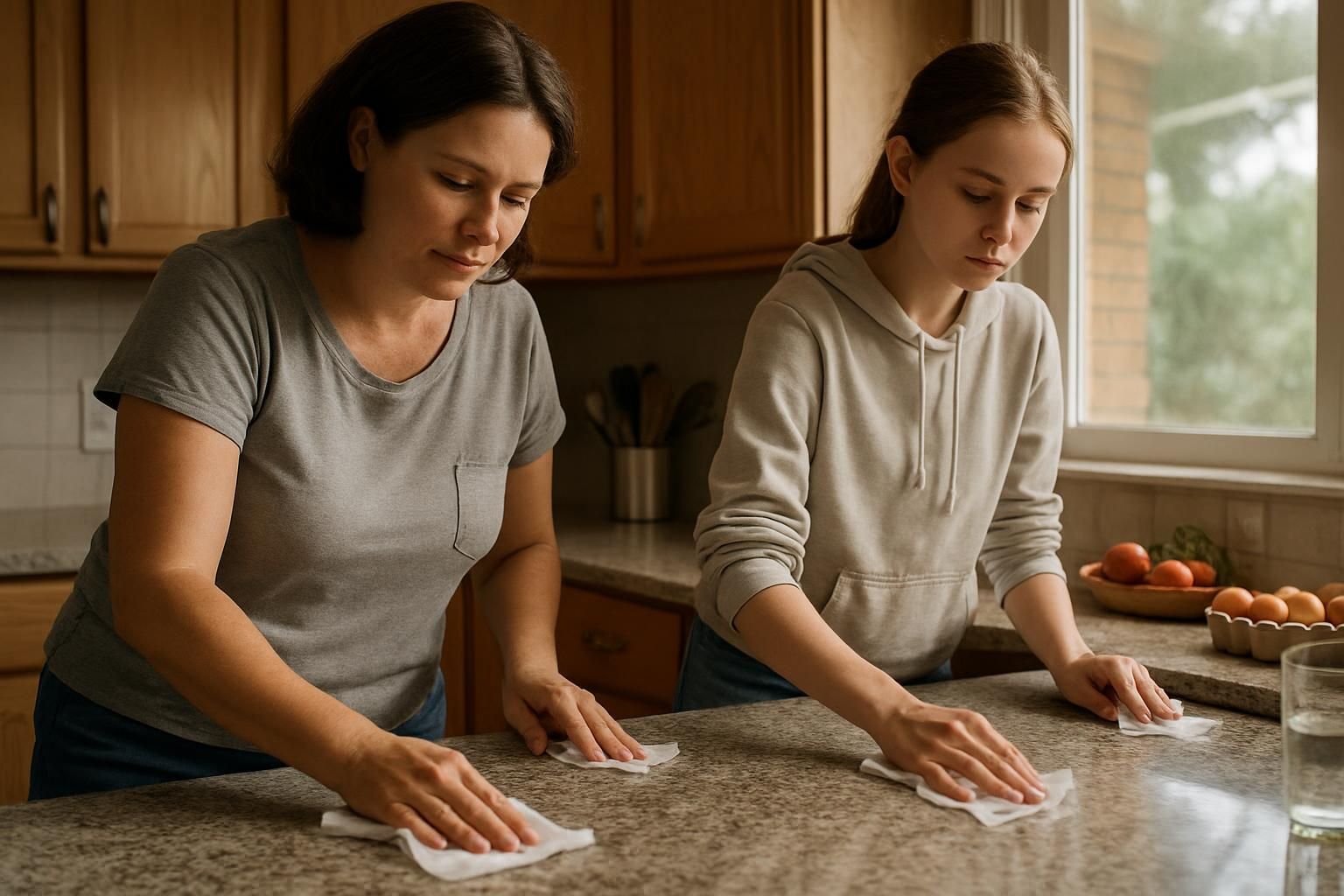
Germs can linger on kitchen counters longer than you think. Safe sanitation methods keep surfaces ready for anything from snack prep to science projects.
Using bleach solutions safely
Rubber gloves stop bleach from soaking into your skin. Housewives and handy dads should always pop them on before touching any bleach solution. For granite, soapstone, or wood surfaces, dilute household bleach with warm water for disinfection.
Use a tablespoon of bleach in one gallon of water to keep chemicals at safe levels without overpowering the air.
Keep windows open to let out strong smells and protect kids’ lungs. Wipe down the surface with the diluted mix using a cloth or sponge; rinse right after with clean water so no residue lingers.
Stronger is never better here a lighter hand keeps countertops clean but also prevents stains and damage.
Now that chemicals have played their part, families can look at alternatives like Free & Clear disinfectants for daily cleaning routines.
Alternatives like Free & Clear disinfectants
Bleach solutions can zap germs fast, but they might not suit every countertop. Free & Clear disinfectants offer a gentler option for homes with little hands and sensitive noses. These disinfecting wipes help control pathogens and handle sanitization without strong fumes.
For laminate, marble, or stainless steel, a non-bleach spray approved for each material knocks out most bacteria in minutes.
Parents worried about harsh chemicals will appreciate these hygiene products. Spray the surface lightly; let it sit to kill unseen microbes. Wipe using a clean cloth afterward to finish up Surface Cleaning and infection control.
On engineered stone or quartz counters, diluted isopropyl alcohol steps in as an effective germicidal solution; rinse thoroughly after use to avoid damage. Keeping countertops safe doesn’t need heavy-duty gear just smart pathogen elimination that keeps your kitchen kid-friendly and spotless!
Sealing Countertops for Longevity
Sealing countertops acts like armor for your kitchen surfaces. Wood needs extra love, so oil butcher block counters each month the first year. After that, treat them every six months with a food-grade conditioner or oil.
Granite and marble tell you when to reseal if water no longer beads up after three or four minutes but seeps in, it is time for another coat. Soapstone shrugs off sealers; instead, give it monthly treatments with mineral oil to keep its deep color.
Quartz, laminate, and engineered stone skip the sealing routine altogether thanks to their factory finish. Stainless steel also dodges sealant but perks up if parents rub lemon oil over fingerprints now and then.
Careful application helps protect finishes from spills and stains while boosting durability across years of breakfast rushes and science projects gone wild. Disinfecting comes next as part of countertop maintenance steps many overlook but shouldn’t miss.
Maintenance Tips for Long-lasting Countertops
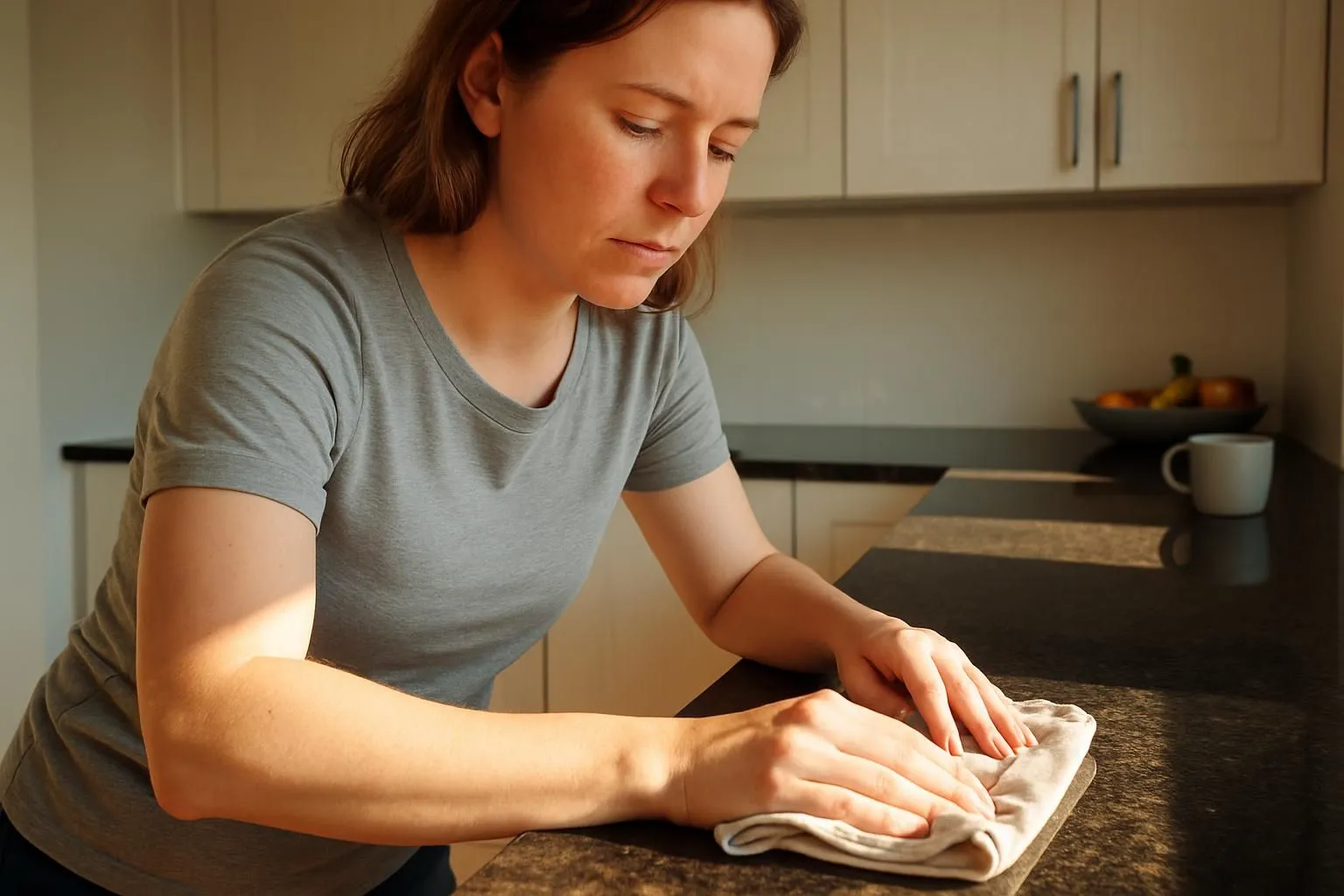
A little care goes a long way for countertop maintenance. Small habits can keep surfaces spotless and ready for anything.
Clean spills immediately
Sticky juice, splattered pasta sauce, and drippy yogurt can sneak into cracks and cause stains if ignored. Grab an absorbent cloth the second a spill happens. Quick countertop care stops liquids from soaking in and causing damage or stubborn marks later.
Food safety matters too; berry juice left behind may hide unseen germs.
Parents know kids drop everything milk, cereal, even art supplies right onto the counter. Move messy foods straight to the sink instead of letting them rest on your kitchen surface.
Cleaning techniques like blotting help prevent extra scrubbing down the line. Protective measures now keep countertops looking sharp for years while fighting off future grime.
Avoid abrasive cleaners
Steel wool and powder cleansers scrape surfaces, making them lose shine and protection. Popular countertop care mistakes include using abrasive cleaners. These products damage sealants on granite, marble, quartz, or laminate countertops.
Over time, rough scrubbing can lead to dull spots and deep scratches.
Families can keep counters smooth and looking new by choosing safe cleaning products made for Surface Cleaning and counter protection. Even a sponge with too much grit can shorten the lifespan of kitchen counters.
Kids might bang toys or drop utensils on your workspace; scratches from harsh scrubbers make that worse fast! For lasting durability in a busy kitchen, trusted maintenance guidelines say to avoid abrasives at all costs.
How to Un-Scorch Countertops
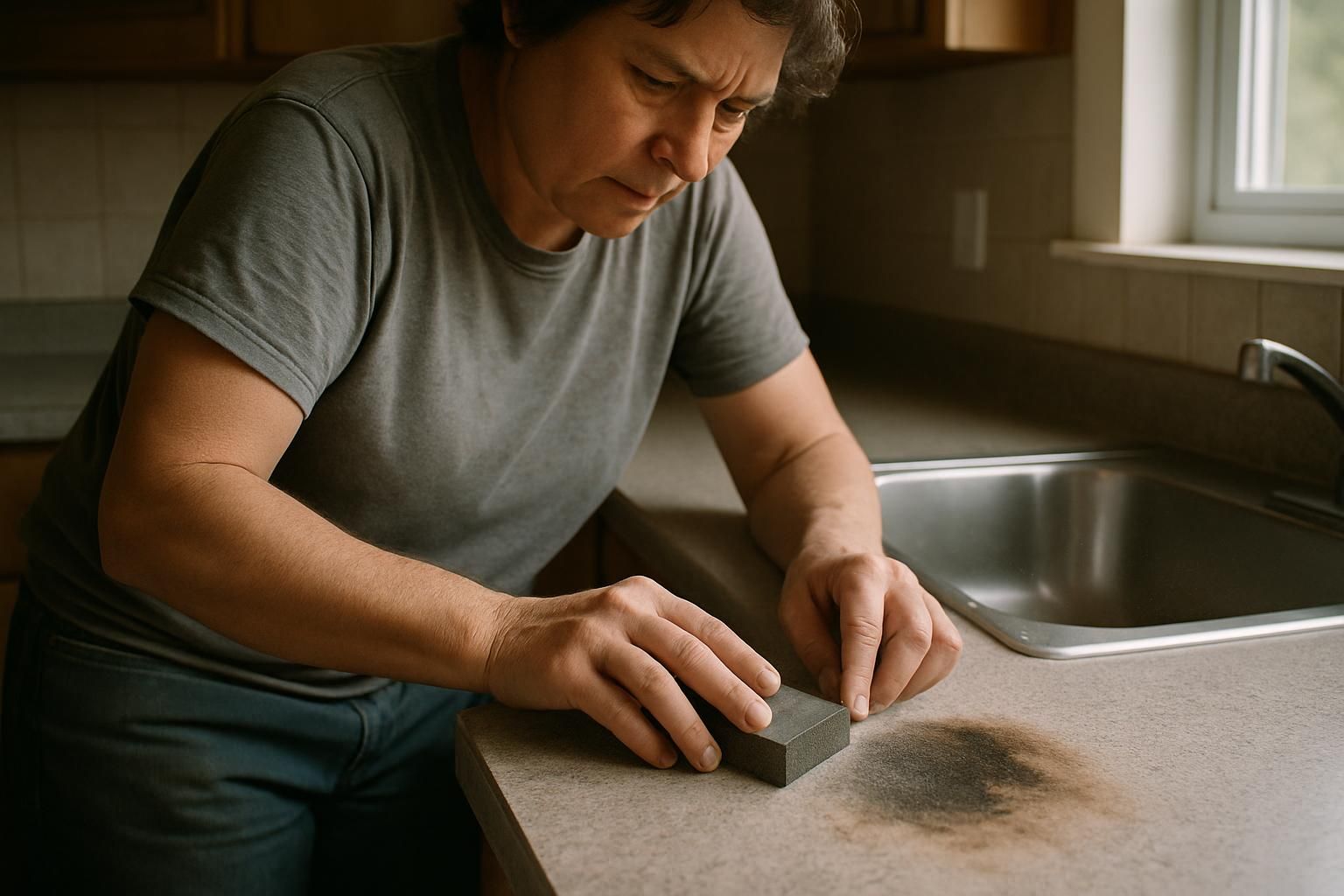
Fixing scorched countertops breathes new life into your kitchen. It saves money and keeps your counters looking great. Here are the steps to un-scorch different types of countertops:
For laminate countertops:
- Start with baking soda or toothpaste as an abrasive cleaner.
- Use a small brush for scrubbing gently.
- Clean the area well with rags before moving to the next step.
- Sand the scorched spot gently with 200-grit sandpaper.
- Apply clear epoxy over the area.
- After the epoxy cures, sand it smooth for a seamless finish.
For butcher block countertops:
- Grab an electric sander and start with 80-grit sandpaper over the scorched area.
- Move up to 150-grit, then finish with 220-grit sandpaper for a smooth surface.
- Clean the dust off thoroughly.
- Finish by applying food-safe butcher block oil, preserving the wood and its appearance.
To remove stains from granite countertops:
- Prepare a poultice from stone-safe ingredients.
- Spread it over the stain carefully.
- Cover with plastic wrap; use a toothpick to poke holes for air circulation.
- Secure edges with painter’s tape to keep it in place.
- Let sit for 24 hours, allowing poultice to draw out the stain.
- Remove and clean the area thoroughly.
- Apply granite sealer as directed, protecting against future stains.
These steps offer practical ways to restore your countertops after accidental scorching or staining, keeping your kitchen’s heart both functional and beautiful without breaking the bank on replacements or professional resurfacing services.
Conclusion
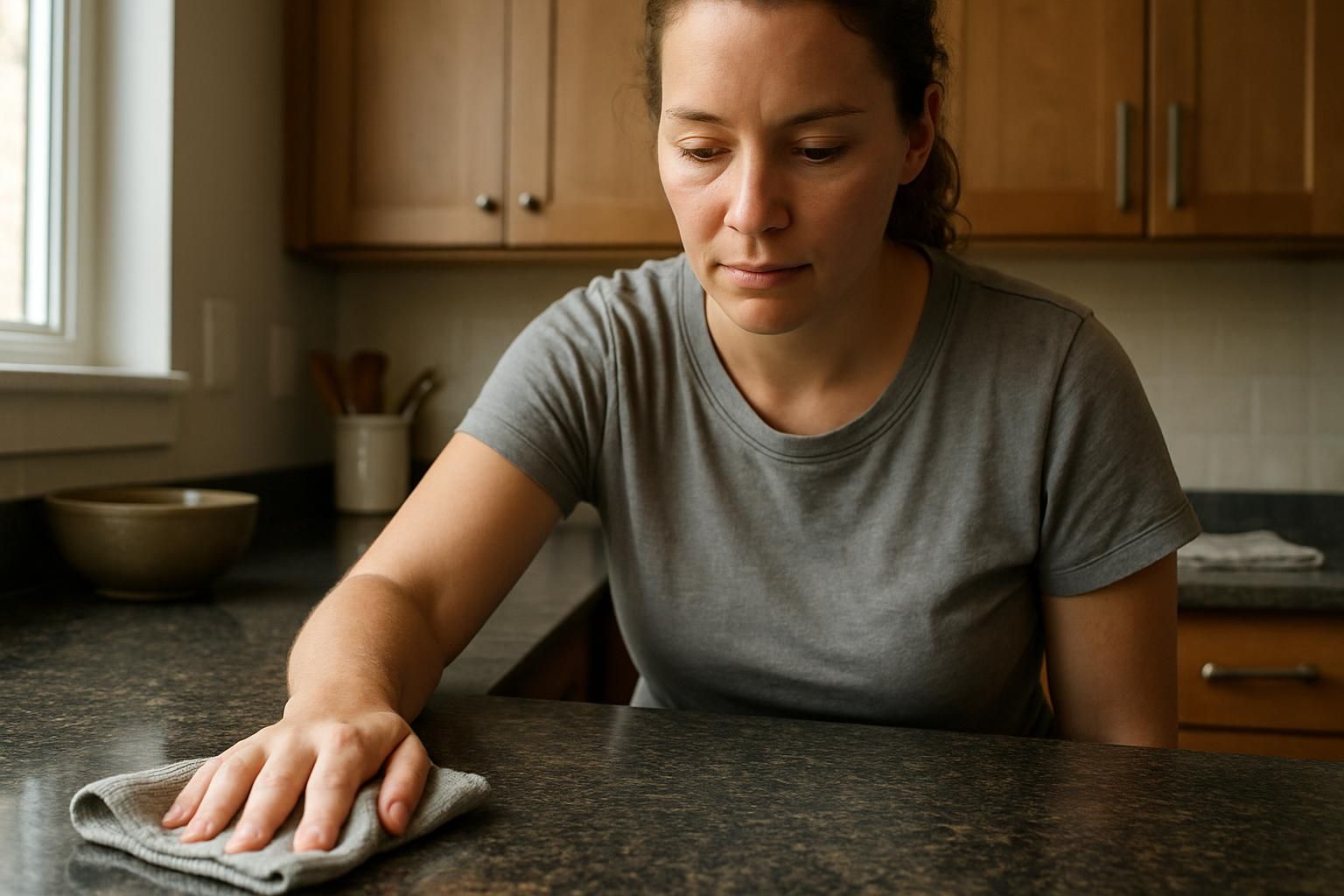
A sparkling kitchen says a lot about its owners. Clean countertops boost Kitchen Hygiene and make cooking easier. Anyone can master surface maintenance with the right tools and tips.
A little daily effort keeps grime at bay and stains off the radar. Stick to frugal, simple habits, and even the busiest parent will feel like a cleaning champion.
FAQs
1. What’s the best way to get a sparkling clean kitchen countertop?
To achieve that coveted shine, you’ll need to wipe down your countertops daily with warm soapy water and a soft cloth. For stubborn stains, consider using specialized cleaning products designed for your countertop material.
2. Can I use vinegar or baking soda on my countertops?
Yes indeed! Vinegar and baking soda are household staples known for their cleaning properties. Test any cleaner in a small, inconspicuous spot first.
3. How often should I be cleaning my kitchen counters?
Well, if you’re asking me this question over coffee, I’d say at least once a day is ideal especially after meal preparation to keep things spick-and-span!
4. Are there any no-no’s when it comes to countertop care?
Absolutely! Avoid using harsh chemicals or abrasive scrubbers on your countertops as they can cause damage over time. Also steer clear of hot pans directly on the surface; trivets are your counter’s best friend!


